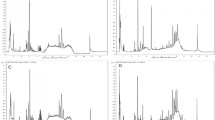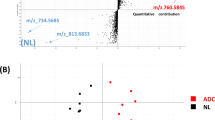Abstract
Lysophosphatidylcholines (lysoPCs) are a class of compounds that have a constant polar head, and fatty acyls of different chain lengths, position, degrees of saturation, and double bond location in human plasma. LysoPCs levels can be a clinical diagnostic indicator that reveals pathophysiological changes. In this work, a method was developed to discriminate between different types of lysoPCs using reversed phase ultra-performance liquid chromatography coupled to quadrupole time-of-flight mass spectrometry, using mass spectrometry MSE. Isomeric lysoPCs were distinguished based on retention time and the peak intensity ratio of product ions, and 14 pairs of lysoPCs regioisomers were identified in human plasma. The plasma samples of 12 lung cancer patients and 12 healthy persons were collected and analyzed by principal component analysis to generate metabolic profiles of the identified lysoPCs. Both electrospray ionization ESI+ and ESI− results showed that all lung cancer patients had the same five lysoPC metabolic abnormalities, specifically in sn-1 lyso16:0, sn-2 lysoPC 16:0, sn-1 lysoPC 18:0, sn-1 lysoPC 18:1 and sn-1 lysoPC 18:2. Thus, the function of isomers with different fatty acyl positions may be related to lung cancer, and this may help elucidate the mechanism of the disease.







Similar content being viewed by others
References
Adlercreutz, D., & Wehtje, E. (2001). A simple HPLC method for the simultaneous analysis of phosphatidylcholine and its partial hydrolysis products 1-and 2-acyl lysophosphatidylcholine. Journal of the American Oil Chemists Society, 78(10), 1007–1011.
Bateman, K. P., Castro-Perez, J., Wrona, M., Shockcor, J. P., Yu, K., Oballa, R., et al. (2007). MSE with mass defect filtering for in vitro and in vivo metabolite identification. Rapid Communications in Mass Spectrometry, 21(9), 1485–1496.
Beckwith-Hall, B. M., Holmes, E., Lindon, J. C., Gounarides, J., Vickers, A., Shapiro, M., et al. (2002). NMR-based metabonomic studies on the biochemical effects of commonly used drug carrier vehicles in the rat. Chemical Research in Toxicology, 15(9), 1136–1141.
Bernhard, W., Pynn, C. J., Jaworski, A., Rau, G. A., Hohlfeld, L. M., Freihorst, J., et al. (2004). Mass spectrometric analysis of surfactant metabolism in human volunteers using deuteriated choline. American Journal of Respiratory and Critical Care Medicine, 170(1), 54–58.
Besterman, J. M., & Domanico, P. L. (1992). Association and metabolism of exogenously-derived lysophosphatidylcholine by cultured-mammalian-cells—Kinetics and mechanisms. Biochemistry, 31(7), 2046–2056.
Bollard, M. E., Holmes, E., Lindon, J. C., Mitchell, S. C., Branstetter, D., Zhang, W., et al. (2001). Investigations into biochemical changes due to diurnal variation and estrus cycle in female rats using high-resolution H-1 NMR spectroscopy of urine and pattern recognition. Analytical Biochemistry, 295(2), 194–202.
Bruce, S. J., Jonsson, P., Antti, H., Cloarec, O., Trygg, J., Marklund, S. L., et al. (2008). Evaluation of a protocol for metabolic profiling studies on human blood plasma by combined ultra-performance liquid chromatography/mass spectrometry: From extraction to data analysis. Analytical Biochemistry, 372(2), 237–249.
Cai, S., Huo, T. G., Li, N., Xiong, Z. L., & Li, F. M. (2009a). Lysophosphatidylcholine-biomarker of Metformin action: studied using UPLC/MS/MS. Biomedical Chromatography, 23(7), 782–786.
Cai, X., Zou, L., Dong, J., Zhao, L., Wang, Y., Xu, Q., et al. (2009b). Analysis of highly polar metabolites in human plasma by ultra-performance hydrophilic interaction liquid chromatography coupled with quadrupole-time of flight mass spectrometry. Analytica Chimica Acta, 650(1), 10–15.
Chen, J., Wang, W., Lv, S., Yin, P., Zhao, X., Lu, X., et al. (2009). Metabonomics study of liver cancer based on ultra performance liquid chromatography coupled to mass spectrometry with HILIC and RPLC separations. Analytica Chimica Acta, 650(1), 3–9.
Creer, M. H., & Gross, R. W. (1985). Separation of isomeric lysophospholipids by reverse phase Hplc. Lipids, 20(12), 922–928.
Fang, N. B., Yu, S. G., & Badger, T. M. (2003). LC-MS/MS analysis of lysophospholipids associated-with soy protein isolate. Journal of Agricultural and Food Chemistry, 51(23), 6676–6682.
Fukushima, N., Kimura, Y., & Chun, J. (1998). A single receptor encoded by vzg-1/lp(A1)/edg-2 couples to G proteins and mediates multiple cellular responses to lysophosphatidic acid. Proceedings of the National Academy of Sciences of the United States of America, 95(11), 6151–6156.
Garcia, A., Newkirk, J. D., & Mavis, R. D. (1975). Lung surfactant synthesis—Ca++-dependent microsomal phospholipase A2 in lung. Biochemical and Biophysical Research Communications, 64(1), 128–135.
Gurr, M. I., Harwood, J. L., & Frayn, K. N. (2002). Lipid biochemistry: An introduction. Oxford: Blackwell Science.
Han, X. L., & Gross, R. W. (1996). Structural determination of lysophospholipid regioisomers by electrospray ionization tandem mass spectrometry. Journal of the American Chemical Society, 118(2), 451–457.
Hirano, K., Matsui, H., Tanaka, T., Matsuura, F., Satouchi, K., & Koike, T. (2004). Production of 1,2-didocosahexaenoyl phosphatidylcholine by bonito muscle lysophosphatidylcholine/transacylase. Journal of Biochemistry, 136(4), 477–483.
Hla, T., Lee, M. J., Ancellin, N., Paik, J. H., & Kluk, M. J. (2001). Lysophospholipids—Receptor revelations. Science, 294(5548), 1875–1878.
Idborg, H., Zamani, L., Edlund, P. O., Schuppe-Koistinen, I., & Jacobsson, S. P. (2005). Metabolic fingerprinting of rat urine by LC/MS Part 2. Data pretreatment methods for handling of complex data. Journal of Chromatography B-Analytical Technologies in the Biomedical and Life Sciences, 828(1–2), 14–20.
Jernstrom, H., Klug, T. L., Sepkovic, D. W., Bradlow, H. L., & Narod, S. A. (2003). Predictors of the plasma ratio of 2-hydroxyestrone to 16 alpha-hydroxyestrone among pre-menopausal, nulliparous women from four ethnic groups. Carcinogenesis, 24(5), 991–1005.
Jia, L. W., Chen, J., Yin, P. Y., Lu, X., & Xu, G. W. (2008). Serum metabonomics study of chronic renal failure by ultra performance liquid chromatography coupled with Q-TOF mass spectrometry. Metabolomics, 4(2), 183–189.
Jia, L. W., Wang, C., Zhao, S. M., Lu, X., & Xu, G. W. (2007). Metabolomic identification of potential phospholipid biomarkers for chronic glomerulonephritis by using high performance liquid chromatography-mass spectrometry. Journal of Chromatography B-Analytical Technologies in the Biomedical and Life Sciences, 860(1), 134–140.
Lands, W. E. M. (1958). Metabolism of glycerolipides—Comparison of lecithin and triglyceride synthesis. Journal of Biological Chemistry, 231(2), 883–888.
Lands, W. E. M. (1960). Metabolism of glycerolipids. 2. Enzymatic acylation of lysolecithin. Journal of Biological Chemistry, 235(8), 2233–2237.
Lenz, E. M., & Wilson, I. D. (2007). Analytical strategies in metabonomics. Journal of Proteome Research, 6, 443–458.
Liebisch, G., Drobnik, W., Lieser, B., & Schmitz, G. (2002). High-throughput quantification of lysophosphatidylcholine by electrospray ionization tandem mass spectrometry. Clinical Chemistry, 48(12), 2217–2224.
Longmore, W. J., Oldenborg, V., & Vangolde, L. M. G. (1979). Phospholipase-A2 in rat-lung microsomes—Substrate-specificity towards endogenous phosphatidylcholines. Biochimica et Biophysica Acta, 572(3), 452–460.
Lu, X., & Xu, G. (2008). LC-MS metabonomics methodology in biomarker discovery. Methods in Pharmacology and Toxicology (pp. 291–315). Totowa: Humana Press Inc.
Morash, S. C., Cook, H. W., & Spence, M. W. (1989). Lysophosphatidylcholine as an intermediate in phosphatidylcholine metabolism and glycerophosphocholine synthesis in cultured-cells—An evaluation of the roles of 1-Acyl-Lysophosphatidylcholine and 2-Acyl-Lysophosphatidylcholine. Biochimica et Biophysica Acta, 1004(2), 221–229.
Nakanishi, H., Shindou, H., Hishikawa, D., Harayama, T., Ogasawara, R., Suwabe, A., et al. (2006). Cloning and characterization of mouse lung-type acyl-CoA: Lysophosphatidylcholine acyltransferase 1 (LPCAT1)—Expression in alveolar type II cells and possible involvement in surfactant production. Journal of Biological Chemistry, 281(29), 20140–20147.
Ohta, M., Hasegawa, H., & Ohno, K. (1972). Calcium independent phospholipase-A2 activity in rat lung supernatant. Biochimica et Biophysica Acta, 280(4), 552–558.
Plumb, R. S., Johnson, K. A., Rainville, P., Smith, B. W., Wilson, I. D., Castro-Perez, J. M., et al. (2006). UPLC/MSE; a new approach for generating molecular fragment information for biomarker structure elucidation (vol 20, pg 1989, 2006). Rapid Communications in Mass Spectrometry, 20(14), 1989–1994.
Postle, A. D., Wilton, D. C., Hunt, A. N., & Attard, G. S. (2007). Probing phospholipid dynamics by electrospray ionisation mass spectrometry. Progress in Lipid Research, 46(3–4), 200–224.
Rainville, P. D., Stumpf, C. L., Shockcor, J. P., Plumb, R. S., & Nicholson, J. K. (2007). Novel application of reversed-phase UPLC-oaTOF-MS for lipid analysis in complex biological mixtures: A new tool for lipidomics. Journal of Proteome Research, 6, 552–558.
Samuelsson, B., Dahlen, S. E., Lindgren, J. A., Rouzer, C. A., & Serhan, C. N. (1987). Leukotrienes and lipoxins—Structures, biosynthesis, and biological effects. Science, 237(4819), 1171–1176.
Shindou, H., Hishikawa, D., Harayama, T., Yuki, K., & Shimizu, T. (2009). Recent progress on acyl CoA: Lysophospholipid acyltransferase research. Journal of Lipid Research, 50, S46–S51.
Solanky, K. S., Bailey, N. J. C., Beckwith-Hall, B. M., Davis, A., Bingham, S., Holmes, E., et al. (2003). Application of biofluid H-1 nuclear magnetic resonance-based metabonomic techniques for the analysis of the biochemical effects of dietary isoflavones on human plasma profile. Analytical Biochemistry, 323(2), 197–204.
Sutphen, R., Xu, Y., Wilbanks, G. D., Fiorica, J., Grendys, E. C., LaPolla, J. P., et al. (2004). Lysophospholipids are potential biomarkers of ovarian cancer. Cancer Epidemiology Biomarkers & Prevention, 13(7), 1185–+.
Theodoridis, G., Gika, H. G., & Wilson, I. D. (2008). LC-MS-based methodology for global metabolite profiling in metabonomics/metabolomics. Trac-Trends in Analytical Chemistry, 27(3), 251–260.
Thies, F., Delachambre, M. C., Bentejac, M., Lagarde, M., & Lecerf, J. (1992). Unsaturated fatty-acids esterified in 2-Acyl-1-Lysophosphatidylcholine bound to albumin are more efficiently taken up by the young-rat brain than the unesterified form. Journal of Neurochemistry, 59(3), 1110–1116.
Wang, C., Kong, H. W., Guan, Y. F., Yang, J., Gu, J. R., Yang, S. L., et al. (2005). Plasma phospholipid metabolic profiling and biomarkers of type 2 diabetes mellitus based on high-performance liquid chromatography/electrospray mass spectrometry and multivariate statistical analysis. Analytical Chemistry, 77(13), 4108–4116.
Want, E. J., O’Maille, G., Smith, C. A., Brandon, T. R., Uritboonthai, W., Qin, C., et al. (2006). Solvent-dependent metabolite distribution, clustering, and protein extraction for serum profiling with mass spectrometry. Analytical Chemistry, 78(3), 743–752.
Yang, J., Xu, G. W., Zheng, Y. F., Kong, H. W., Pang, T., Lv, S., et al. (2004). Diagnosis of liver cancer using HPLC-based metabonomics avoiding false-positive result from hepatitis and hepatocirrhosis diseases. Journal of Chromatography B-Analytical Technologies in the Biomedical and Life Sciences, 813(1–2), 59–65.
Yang, J., Zhao, X. J., Liu, X. L., Wang, C., Gao, P., Wang, J. S., et al. (2006). High performance liquid chromatography-mass spectrometry for metabonomics: Potential biomarkers for acute deterioration of liver function in chronic hepatitis B. Journal of Proteome Research, 5(3), 554–561.
Yin, P. Y., Zhao, X. J., Li, Q. R., Wang, J. S., Li, J. S., & Xu, G. W. (2006). Metabonomics study of intestinal fistulas based on ultraperformance liquid chromatography coupled with Q-TOF mass spectrometry (UPLC/Q-TOF MS). Journal of Proteome Research, 5(9), 2135–2143.
Zha, W., A, J. Y., Wang, G., Yan, B., Gu, S., Zhu, X., et al. (2009). Metabonomic characterization of early atherosclerosis in hamsters with induced cholesterol. Biomarkers, 14(6), 372–380.
Zhang, F. X., Jia, Z. H., Gao, P., Kong, H. W., Li, X., Chen, J., et al. (2009a). Metabonomics study of atherosclerosis rats by ultra fast liquid chromatography coupled with ion trap-time of flight mass spectrometry. Talanta, 79(3), 836–844.
Zhang, J., Yan, L., Chen, W., Lin, L., Song, X., Yan, X., et al. (2009b). Metabonomics research of diabetic nephropathy and type 2 diabetes mellitus based on UPLC-oaTOF-MS system. Analytica Chimica Acta, 650(1), 16–22.
Zhang, J., Yan, L. J., Lin, L., Chen, W. G., Song, X. Y., Yan, X. M., et al. (2008). Metabonomics research of diabetes mellitus and diabetic nephropathy based on UPLC-oaTOF-MS system. Chemical Journal of Chinese Universities-Chinese, 29(11), 2171–2173.
Acknowledgements
We acknowledge the grant of Project of National Science Foundation of China (20805046 and 30770646) and Project of International Cooperation Plan from Ministry of Science and Technology of China (2007DFC30550).
Author information
Authors and Affiliations
Corresponding authors
Rights and permissions
About this article
Cite this article
Dong, J., Cai, X., Zhao, L. et al. Lysophosphatidylcholine profiling of plasma: discrimination of isomers and discovery of lung cancer biomarkers. Metabolomics 6, 478–488 (2010). https://doi.org/10.1007/s11306-010-0215-x
Received:
Accepted:
Published:
Issue Date:
DOI: https://doi.org/10.1007/s11306-010-0215-x




